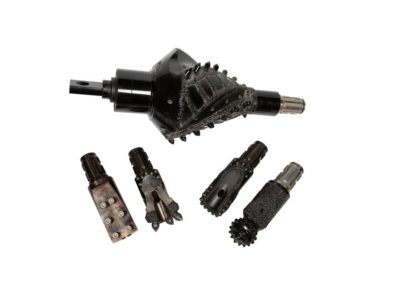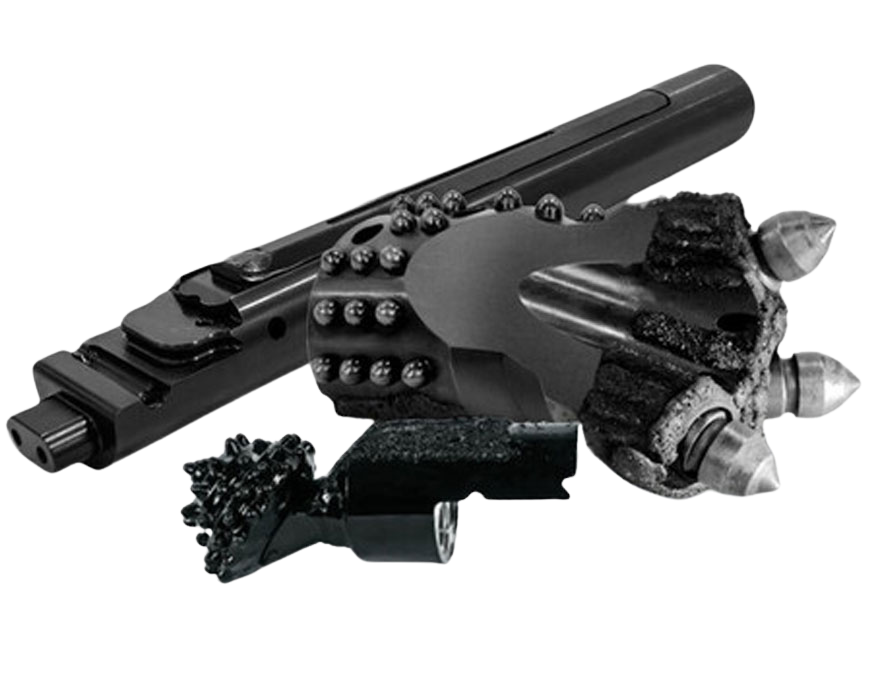When it comes to choosing the right tooling for your horizontal directional drills, there are plenty of options. At Vermeer, there are four main tooling families to choose from: Armor, Ultra, Quickfire® connection system and Quickfire HD system. Each one has a unique purpose to help you drill in challenging ground conditions and picking the right one depends on your jobsite and preferences. Here’s a breakdown of each tooling system to help you choose.
Armor
Armor system is a modular soft rock drilling platform, a housing and a family of bits that allow you to perform in different types of rock, such as cobble, soft formations and limestone.
“The value of Armor is that it can get through tough rock without specialized rigs or specialized systems, like an air hammer,” said Cody Mecham, a Cutting Edge product manager at Vermeer. “Also, the changeout is quick when you want to switch out the bit in the pit.”
You don’t have to use breakout tongs or break anything loose to change out the bit in the entry or exit pit. You can quickly put a swivel on the end and pull back with it to get the job done.
Ultra
The next tooling system, Ultra, is similar to Armor. It’s a drill head system, and a non-torqued option for bit changeouts. There are also Armor bits that are offered that have an Ultra connection.
The biggest difference between Armor and Ultra is that Ultra isn’t targeted at just soft rock – it’s designed for all kinds of ground conditions. An Ultra dirt bit adapter and regular plate bit are available, so you can drill like you normally would in dirt.
“The Ultra tooling system is a jack of all trades,” explained Mecham. “It’s one housing that you’ll use for dirt to soft rock or most ground conditions.”
The Ultra platform can also be reamed off of. You can pilot out with the bit of your choice and then remove that to go to a swivel, or you can use a reamer on the front side and pull back using your housing.
“With the Ultra system you can have a much more restrained exit pit,” said Mecham. “The operator can drill out into the exit pit and can put a reamer directly on the front of the housing, eliminating the need to expose the entire drill head.”
Another benefit to the Ultra system is the use of electronics in the head.
“Many times when you ream, you can lose track of where you’re at, and only count based on the number of drill rod that you’ve used,” said Mecham. “In the Ultra tooling system, it utilizes the electronics in the head so you can track it with a location system, that way you know where you’re at all times during the bore.”
Quickfire® connection system
Then there’s the Quickfire system, a quick connect starter rod system.
Quickfire system has a course tapered-style thread, which allows you to achieve makeup with fewer revolutions. With Quickfire system, only four turns are needed. To change it out, all that’s required is to remove a couple bolts, take the collar off, and you can take off the reamer or bit without a torqued connection.
This is the evolution of the low profile thread (LPT). Quickfire system utilizes an octo-collar versus the hex collar on LPT. Having eight flats decreases flat to flat distance, making for quicker makeup time.
“It wasn’t just a thread enhancement to make it quicker to go together,” explained Mecham. “The strength of the Quickfire tooling system is greater than LPT.”
Quickfire HD system
Last, but definitely not least, is Quickfire HD tooling system, which stands for heavy-duty. It can be used in rock or hard ground conditions. Basically, when you’re drilling in tough ground or extreme conditions, Quickfire HD system is the way to go.
Quickfire HD system has a similar premise, the same thread and the same eight-sided collar as Quickfire system. The biggest difference between the two is the orientation of the connection. On Quickfire system, the reamer or the head is a pin and the starter is a box connection. On Quickfire HD system, it’s flipped to help with collar life.
Another unique thing about Quickfire HD system is the collar retention method. On Quickfire HD system, the collar is held with two roll pins. Quickfire system has two bolts to retain the collar. A lot of internal testing and industry research found that the roll pin configuration of the Quickfire HD system is stronger under chatter and extreme conditions.
With Quickfire HD system, you no longer have to index your collar. With Quickfire system and LPT, you have to make sure the bolt hole(s) on the collar are in the same orientation as the bolt holes on your tool joint. With Quickfire HD system, you don’t have to do that anymore. All you have to do is put the pins in.
“Another issue that can happen, depending on the ground conditions and the system you’re using, is screws could come loose and shear off,” said Mecham. “With the Quickfire HD system pins, they’re ideal for handling vibration and are flush with the system, so they’re less likely to shear off.”
Each of these four tooling systems have a unique use and purpose. Your jobsite, tooling needs and ground conditions will help factor into what tooling system you should choose. If you have any questions or want more information, reach out to your local Vermeer dealer today.
Vermeer Corporation reserves the right to make changes in engineering, design and specifications; add improvements; or discontinue manufacturing at any time without notice or obligation. Equipment shown is for illustrative purposes only and may display optional accessories or components specific to their global region. Please contact your local Vermeer dealer for more information on machine specifications.
Vermeer, the Vermeer logo, Equipped to Do More and QuickFire are trademarks of Vermeer Manufacturing Company in the U.S. and/or other countries. © 2022 Vermeer Corporation. All Rights Reserved.

